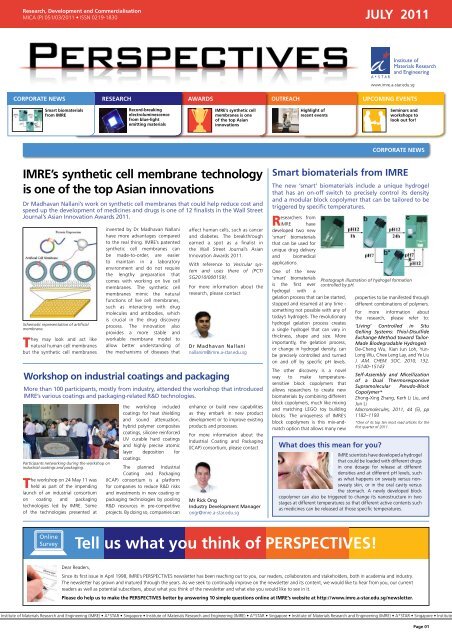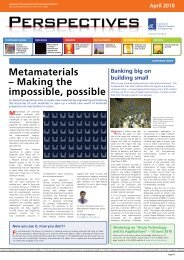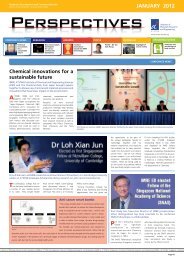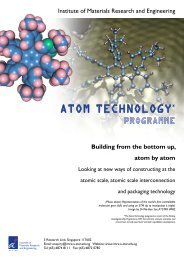Tell us what you think of PERSPECTIVES! - IMRE - A*Star
Tell us what you think of PERSPECTIVES! - IMRE - A*Star
Tell us what you think of PERSPECTIVES! - IMRE - A*Star
Create successful ePaper yourself
Turn your PDF publications into a flip-book with our unique Google optimized e-Paper software.
Research, Development and Commercialisation<br />
MICA (P) 051/03/2011 • ISSN 0219-1830 JULY 2011<br />
CORPORATE NEWS<br />
Smart biomaterials<br />
from <strong>IMRE</strong><br />
Institute <strong>of</strong><br />
Materials Research<br />
and Engineering<br />
www.imre.a-star.edu.sg<br />
RESEARCH AWARDS OUTREACH<br />
UPCOMING EVENTS<br />
Record-breaking<br />
electroluminescence<br />
from blue-light<br />
emitting materials<br />
<strong>IMRE</strong>’s synthetic cell<br />
membranes is one<br />
<strong>of</strong> the top Asian<br />
innovations<br />
<strong>IMRE</strong>’s synthetic cell membrane technology<br />
is one <strong>of</strong> the top Asian innovations<br />
Dr Madhavan Nallani’s work on synthetic cell membranes that could help reduce cost and<br />
speed up the development <strong>of</strong> medicines and drugs is one <strong>of</strong> 12 finalists in the Wall Street<br />
Journal’s Asian Innovation Awards 2011.<br />
Schematic representation <strong>of</strong> artificial<br />
membrane.<br />
They may look and act like<br />
natural human cell membranes<br />
but the synthetic cell membranes<br />
Online<br />
Survey<br />
invented by Dr Madhavan Nallani<br />
have more advantages compared<br />
to the real thing. <strong>IMRE</strong>’s patented<br />
synthetic cell membranes can<br />
be made-to-order, are easier<br />
to maintain in a laboratory<br />
environment and do not require<br />
the lengthy preparation that<br />
comes with working on live cell<br />
membranes. The synthetic cell<br />
membranes mimic the natural<br />
functions <strong>of</strong> live cell membranes,<br />
such as interacting with drug<br />
molecules and antibodies, which<br />
is crucial in the drug discovery<br />
process. The innovation also<br />
provides a more stable and<br />
workable membrane model to<br />
allow better understanding <strong>of</strong><br />
the mechanisms <strong>of</strong> diseases that<br />
Dr Madhavan Nallani<br />
nallanim@imre.a-star.edu.sg<br />
Workshop on ind<strong>us</strong>trial coatings and packaging<br />
More than 100 participants, mostly from ind<strong>us</strong>try, attended the workshop that introduced<br />
<strong>IMRE</strong>’s vario<strong>us</strong> coatings and packaging-related R&D technologies.<br />
Participants networking during the workshop on<br />
ind<strong>us</strong>trial coatings and packaging.<br />
The workshop on 24 May 11 was<br />
held as part <strong>of</strong> the impending<br />
launch <strong>of</strong> an ind<strong>us</strong>trial consortium<br />
on coating and packaging<br />
technologies led by <strong>IMRE</strong>. Some<br />
<strong>of</strong> the technologies presented at<br />
the workshop included<br />
coatings for heat shielding<br />
and sound attenuation,<br />
hybrid polymer composites<br />
coatings, silicone reinforced<br />
UV curable hard coatings<br />
and highly precise atomic<br />
layer deposition for<br />
coatings.<br />
The planned Ind<strong>us</strong>trial<br />
Coating and Packaging<br />
(ICAP) consortium is a platform<br />
for companies to reduce R&D risks<br />
and investments in new coating or<br />
packaging technologies by pooling<br />
R&D resources in pre-competitive<br />
projects. By doing so, companies can<br />
affect human cells, such as cancer<br />
and diabetes. The breakthrough<br />
earned a spot as a finalist in<br />
the Wall Street Journal’s Asian<br />
Innovation Awards 2011.<br />
With reference to Vesicular system<br />
and <strong>us</strong>es there <strong>of</strong> (PCT/<br />
SG2010/000159).<br />
For more information about the<br />
research, please contact<br />
enhance or build new capabilities<br />
as they embark in new product<br />
development or to improve existing<br />
products and processes.<br />
For more information about the<br />
Ind<strong>us</strong>trial Coating and Packaging<br />
(ICAP) consortium, please contact<br />
Mr Rick Ong<br />
Ind<strong>us</strong>try Development Manager<br />
ongr@imre.a-star.edu.sg<br />
Highlight <strong>of</strong><br />
recent events<br />
<strong>Tell</strong> <strong>us</strong> <strong>what</strong> <strong>you</strong> <strong>think</strong> <strong>of</strong> <strong>PERSPECTIVES</strong>!<br />
Seminars and<br />
workshops to<br />
look out for!<br />
CORPORATE NEWS<br />
Smart biomaterials from <strong>IMRE</strong><br />
The new ‘smart’ biomaterials include a unique hydrogel<br />
that has an on-<strong>of</strong>f switch to precisely control its density<br />
and a modular block copolymer that can be tailored to be<br />
triggered by specific temperatures.<br />
Researchers from<br />
<strong>IMRE</strong> have<br />
developed two new<br />
‘smart’ biomaterials<br />
that can be <strong>us</strong>ed for<br />
unique drug delivery<br />
and biomedical<br />
applications.<br />
One <strong>of</strong> the new<br />
‘smart’ biomaterials<br />
is the first ever<br />
hydrogel with a<br />
gelation process that can be started,<br />
stopped and resumed at any time -<br />
something not possible with any <strong>of</strong><br />
today’s hydrogels. The revolutionary<br />
hydrogel gelation process creates<br />
a single hydrogel that can vary in<br />
thickness, shape and size. More<br />
importantly, the gelation process,<br />
or change in hydrogel density, can<br />
be precisely controlled and turned<br />
on and <strong>of</strong>f by specific pH levels.<br />
The other discovery is a novel<br />
way to make temperaturesensitive<br />
block copolymers that<br />
allows researchers to create new<br />
biomaterials by combining different<br />
block copolymers, much like mixing<br />
and matching LEGO toy building<br />
blocks. The uniqueness <strong>of</strong> <strong>IMRE</strong>’s<br />
block copolymers is this mix-andmatch<br />
option that allows many new<br />
Photograph ill<strong>us</strong>tration <strong>of</strong> hydrogel formation<br />
controlled by pH.<br />
What does this mean for <strong>you</strong>?<br />
properties to be manifested through<br />
different combinations <strong>of</strong> polymers.<br />
For more information about<br />
the research, please refer to:<br />
‘Living’ Controlled in Situ<br />
Gelling Systems: Thiol-Disulfide<br />
Exchange Method toward Tailor-<br />
Made Biodegradable Hydrogels<br />
De-Cheng Wu, Xian Jun Loh, Yun-<br />
Long Wu, Chee Leng Lay, and Ye Liu<br />
J. AM. CHEM. SOC. 2010, 132,<br />
15140–15143<br />
Self-Assembly and Micellization<br />
<strong>of</strong> a Dual Thermoresponsive<br />
Supramolecular Pseudo-Block<br />
Copolymer*<br />
Zhong-Xing Zhang, Kerh Li Liu, and<br />
Jun Li<br />
Macromolecules, 2011, 44 (5), pp<br />
1182–1193<br />
*One <strong>of</strong> its top ten most read articles for the<br />
first quarter <strong>of</strong> 2011.<br />
<strong>IMRE</strong> scientists have developed a hydrogel<br />
that could be loaded with different drugs<br />
in one dosage for release at different<br />
densities and at different pH levels, such<br />
as <strong>what</strong> happens on sweaty vers<strong>us</strong> nonsweaty<br />
skin, or in the oral cavity vers<strong>us</strong><br />
the stomach. A newly developed block<br />
copolymer can also be triggered to change its nanostructure in two<br />
stages at different temperatures so that different active contents such<br />
as medicines can be released at those specific temperatures.<br />
Dear Readers,<br />
Since its first issue in April 1998, <strong>IMRE</strong>’s <strong>PERSPECTIVES</strong> newsletter has been reaching out to <strong>you</strong>, our readers, collaborators and stakeholders, both in academia and ind<strong>us</strong>try.<br />
The newsletter has grown and matured through the years. As we seek to continually improve on the newsletter and its content, we would like to hear from <strong>you</strong>, our current<br />
readers as well as potential subscribers, about <strong>what</strong> <strong>you</strong> <strong>think</strong> <strong>of</strong> the newsletter and <strong>what</strong> else <strong>you</strong> would like to see in it.<br />
Please do help <strong>us</strong> to make the <strong>PERSPECTIVES</strong> better by answering 10 simple questions online at <strong>IMRE</strong>’s website at http://www.imre.a-star.edu.sg/newsletter.<br />
Institute <strong>of</strong> Materials Research and Engineering (<strong>IMRE</strong>) • A*STAR • Singapore • Institute <strong>of</strong> Materials Research and Engineering (<strong>IMRE</strong>) • A*STAR • Singapore • Institute <strong>of</strong> Materials Research and Engineering (<strong>IMRE</strong>) • A*STAR • Singapore • Institute<br />
Page 01
Publication highlights<br />
Listed below are some noteworthy <strong>IMRE</strong> research<br />
publications.<br />
Page 02<br />
RESEARCH<br />
Record-breaking electroluminescence from bluelight<br />
emitting materials<br />
Achieving Highly Efficient Fluorescent Blue Organic Light-Emitting<br />
Diodes Through Optimizing Molecular Structures and Device<br />
Configuration; Adv. Funct. Mater. 2011, 21, 699–707; Chang-Gua Zhen,<br />
Yan-Feng Dai, Wen-Jin Zeng, Zhun Ma, Zhi-Kuan Chen, John Kieffer<br />
Abstract: Based<br />
on the results <strong>of</strong><br />
first-principles<br />
calculations <strong>of</strong><br />
the electronic<br />
properties <strong>of</strong> blue<br />
light-emitting<br />
materials, the<br />
molecular<br />
structures <strong>of</strong><br />
olig<strong>of</strong>luorenes<br />
were optimised<br />
by incorporating<br />
electronwithdrawing<br />
groups into the molecules to balance<br />
hole and electron injection and<br />
transport for organic light-emitting<br />
diodes (OLEDs). This resulted in a<br />
remarkable improvement in the<br />
maximum external quantum efficiency<br />
(EQE) <strong>of</strong> the undoped device from<br />
2.0% to 4.99%. Further optimisation<br />
“…pure blue emission<br />
with an extremely high<br />
maximum EQE <strong>of</strong> 9.40%<br />
was achieved...”<br />
<strong>of</strong> the device configurations and<br />
processing procedures led to a<br />
very high maximum EQE <strong>of</strong> 7.40%<br />
for the undoped sky-blue device.<br />
Finally, by doping the emitter in a<br />
suitable host material and at the<br />
optimal concentration <strong>of</strong> 6%, pure<br />
blue emission with an extremely<br />
high maximum EQE <strong>of</strong> 9.40% was<br />
achieved, which trumps the current<br />
The new material was <strong>us</strong>ed to produce this deep blue<br />
organic light emitting diode (OLED) that is driven at 6V.<br />
theoretical 5% maximum limit. The<br />
achievement allows manufacturers <strong>of</strong><br />
full colour OLED displays to <strong>us</strong>e the new<br />
materials to make devices that have<br />
significantly longer lifetime, consume<br />
less power and more importantly, can<br />
emit pure, and brighter blue light to<br />
give more life-like colours to OLED<br />
displays. This could greatly enhance<br />
the attractiveness <strong>of</strong> OLED displays in<br />
the consumer market.<br />
For more information about the<br />
publication, please contact<br />
Dr Chen Zhikuan<br />
zk-chen@imre.a-star.edu.sg<br />
New method allows greater variety <strong>of</strong> deposited metals on<br />
semiconductor nanorods<br />
World experts in <strong>IMRE</strong> for atomic<br />
interconnection tool workshop<br />
Experts from around the globe<br />
gathered in <strong>IMRE</strong> for a workshop<br />
on atomic scale interconnection<br />
machines. The event was held as part<br />
<strong>of</strong> the European Union’s €10 million<br />
Atomic Scale and Single Molecule<br />
Logic Gate Technologies, or AtMol<br />
project in which <strong>IMRE</strong> is the only<br />
non-EU partner. The project lays the<br />
foundation for creating and testing a<br />
molecule-sized processor chip.<br />
The atomic scale interconnection<br />
machines are <strong>us</strong>ed to physically<br />
move atoms into place one-by-one<br />
to construct atomic scale circuits at<br />
cryogenic temperatures. The tools<br />
are also able to interconnect the tiny<br />
circuits <strong>of</strong> the device to the external<br />
environment.<br />
The machines are essentially miniature<br />
high precision scanning tunnelling<br />
microscopes (STMs) that can image a<br />
surface with picometer precision and<br />
manipulate one atom or molecule at<br />
a time. The STMs are coupled to a<br />
high-resolution electron microscope<br />
that allows a researcher to position<br />
interconnects to make an atomic<br />
Light-Induced Selective Deposition <strong>of</strong> Metals on Gold-Tipped CdSe-Seeded CdS Nanorods; J. Am. Chem.<br />
Soc. 2011, 133, 672–675; Xinheng Li, Jie Lian, Ming Lin, and Yinthai Chan<br />
Abstract: A new approach for the<br />
selective deposition <strong>of</strong> metals on Autipped<br />
CdSe-seeded CdS nanorods<br />
<strong>us</strong>ing UV excitation was developed.<br />
This light-induced deposition<br />
method allowed Pd to be selectively<br />
deposited under mild conditions,<br />
which produced a Pd/Au alloyed<br />
tip while preserving the rest <strong>of</strong> the<br />
semiconductor nanoarchitecture.<br />
Before the success <strong>of</strong> this method,<br />
the metals that could be deposited<br />
on semiconductor nanorods were<br />
limited beca<strong>us</strong>e only mild chemicals<br />
could be <strong>us</strong>ed. The chemicals needed<br />
in conventional treatment had to be<br />
mild so that it would not degrade<br />
the semiconductor nanorod, which<br />
would affect the performance and<br />
photocatalytic properties <strong>of</strong> the<br />
metal-semiconductor nanorods.<br />
This research effectively expands<br />
on the range <strong>of</strong> metals that can<br />
be deposited on heterostructured<br />
Metal-semiconductor matchstick-like<br />
structure viewed under high-powered<br />
transmission electron microscopy.<br />
“This research<br />
effectively expands on<br />
the range <strong>of</strong> metals<br />
that can be deposited<br />
on heterostructured<br />
semiconductor nanorods...”<br />
semiconductor nanorods, opening<br />
up new avenues for the hierarchical<br />
Institute <strong>of</strong><br />
Materials Research<br />
and Engineering<br />
<strong>IMRE</strong> hosts workshop on the advanced tools needed to build a molecule-sized chip.<br />
Participants <strong>of</strong> <strong>IMRE</strong>’s international workshop on atomic scale interconnection<br />
machines.<br />
buildup <strong>of</strong> structural complexity<br />
and therefore multifunctionality<br />
in nanoparticles. The researchers<br />
are already looking at <strong>us</strong>ing the<br />
new method to produce materials<br />
that have ‘green’ photocatalytic<br />
applications such as materials that<br />
enhance water-splitting to produce<br />
hydrogen more efficiently for fuel<br />
cell; and materials that actively<br />
degrade environmental pollutants<br />
on exposed surfaces like buildings<br />
and cars.<br />
For more information about the<br />
publication, please contact<br />
Dr Chan Yin Thai<br />
chanyt@imre.a-star.edu.sg<br />
scale circuit. Speakers from Europe,<br />
USA, Japan, Canada, A<strong>us</strong>tralia and<br />
Singapore disc<strong>us</strong>sed advancements<br />
in ultra-high vacuum (UHV) tools and<br />
plans for the next generation tools.<br />
“Beca<strong>us</strong>e we are working at the scale<br />
<strong>of</strong> the atom, our tools have to be<br />
ultra high-precision and <strong>of</strong> extremely<br />
high-calibre, j<strong>us</strong>t like <strong>IMRE</strong>’s UHV<br />
interconnection machine, which is one<br />
<strong>of</strong> the three in AtMol that can study the<br />
performance <strong>of</strong> single molecule and<br />
surface atom circuit logic gates”, said<br />
the AtMol project leader, Pr<strong>of</strong> Christian<br />
Joachim <strong>of</strong> the French Centre National<br />
de la Recherche Scientifique (CNRS)<br />
and an A*STAR Visiting Investigator at<br />
<strong>IMRE</strong>. “This workshop brings together<br />
the world’s foremost experts to disc<strong>us</strong>s<br />
the latest in atomic interconnection<br />
machine technology and how this can<br />
quicken the pace towards a working<br />
molecular chip.”<br />
“The tools and the level <strong>of</strong> expertise<br />
that <strong>IMRE</strong> is contributing to this project<br />
show that the research in Singapore<br />
is truly at the cutting edge <strong>of</strong> global<br />
science”, said Pr<strong>of</strong> Andy Hor, Executive<br />
CORPORATE NEWS<br />
How low can <strong>you</strong> go?<br />
<strong>IMRE</strong> built the world’s first<br />
controllable molecular gear.<br />
The AtMol project is part <strong>of</strong><br />
research that is looking at new<br />
ways to build miniaturised<br />
devices and electronics. It is<br />
estimated that conventional<br />
methods for miniaturising<br />
devices will reach their limit<br />
in 10-15 years and cannot<br />
be reduced further. This<br />
method is a leading alternative<br />
in the race to achieve<br />
continued miniaturisation <strong>of</strong><br />
nanoelectronic devices. The<br />
research team in <strong>IMRE</strong> is one<br />
<strong>of</strong> the pioneers in atomic<br />
scale technology, having built<br />
the world’s first controllable<br />
molecular gear and constructed<br />
the smallest digital logic gate<br />
<strong>us</strong>ing a single molecule. <strong>IMRE</strong><br />
also ho<strong>us</strong>es one <strong>of</strong> the few<br />
R&D tools worldwide that is<br />
powerful enough to study<br />
single molecule logic gates and<br />
surface atom circuit logic gates.<br />
Director <strong>of</strong> <strong>IMRE</strong>. “<strong>IMRE</strong> is extremely<br />
glad to host the event and be a part<br />
<strong>of</strong> a truly momento<strong>us</strong> scientific effort.”<br />
‘Machines that build and connect atomic<br />
scale circuits’ infographics on page 3<br />
New ambipolar polymer semiconductors for<br />
flexible plastic electronic devices<br />
A Low-Bandgap Diketopyrrolopyrrole-Benzothiadiazole-Based<br />
Copolymer for High-Mobility Ambipolar Organic Thin-Film<br />
Transistors; Adv. Mater. 2010, 22, 5409–5413; Prashant Sonar,<br />
Samarendra P. Singh, Yuning Li, Mui Siang Soh and Ananth<br />
Dodabalapur<br />
Abstract: A new solution<br />
processable, low band gap polymer<br />
semiconductor comprised <strong>of</strong> donoracceptor<br />
blocks was designed and<br />
synthesised via Suzuki coupling.<br />
The new ambipolar polymer<br />
semiconductor has improved<br />
intermolecular interactions due to<br />
π-π stacking <strong>of</strong> donor and acceptor<br />
blocks. The polymer exhibits<br />
ambipolar charge transport which<br />
“The balanced hole and<br />
electron mobility values<br />
are among the highest for<br />
single component ambipolar<br />
organic thin-film<br />
semiconductors…”<br />
RESEARCH<br />
allows the transport <strong>of</strong> both<br />
positive (holes) and negative<br />
(electrons) charges. The hole<br />
and electron mobilities are<br />
0.35 cm 2 /V.s and 0.40 cm 2 /V.s,<br />
respectively when <strong>us</strong>ed as the<br />
active semiconductor in organic<br />
thin-film transistor (OTFT) devices.<br />
The balanced hole and electron<br />
mobility values are among the<br />
highest for single component<br />
ambipolar organic thin-film<br />
semiconductors that have been<br />
reported so far. The new polymer<br />
is simpler to manufacture, easy<br />
to process and is suitable for<br />
creating electronic circuits. This<br />
polymer has the potential to be<br />
(continued on page 4)<br />
Institute <strong>of</strong> Materials Research and Engineering (<strong>IMRE</strong>) • A*STAR • Singapore • Institute <strong>of</strong> Materials Research and Engineering (<strong>IMRE</strong>) • A*STAR • Singapore • Institute <strong>of</strong> Materials Research and Engineering (<strong>IMRE</strong>) • A*STAR • Singapore • Institute
Institute <strong>of</strong><br />
Materials Research<br />
and Engineering<br />
CORPORATE NEWS<br />
<strong>of</strong> Materials Research and Engineering (<strong>IMRE</strong>) • A*STAR • Singapore • Institute <strong>of</strong> Materials Research and Engineering (<strong>IMRE</strong>) • A*STAR • Singapore • Institute <strong>of</strong> Materials Research and Engineering (<strong>IMRE</strong>) • A*STAR • Singapore • Institute <strong>of</strong> Mater<br />
Page 03
(continued from page 2)<br />
Institute <strong>of</strong><br />
Materials Research<br />
and Engineering<br />
27 May 11<br />
<strong>IMRE</strong> hosted a visit for students<br />
<strong>of</strong> the Singapore International<br />
Science Challenge (SISC) 2011,<br />
a biannual international science<br />
competition organised by the<br />
National Junior College (NJC) to<br />
provide opportunity for students<br />
from different countries to interact<br />
and showcase their research<br />
projects. The students were introduced to <strong>IMRE</strong>’s research on functional<br />
silk, water analyser technology and materials characterisation.<br />
Institute <strong>of</strong> Materials Research and Engineering (<strong>IMRE</strong>) • A*STAR • Singapore • Institute <strong>of</strong> Materials Research and Engineering (<strong>IMRE</strong>) • A*STAR • Singapore • Institute <strong>of</strong> Materials Research and Engineering (<strong>IMRE</strong>) • A*STAR • Singapore • Institute<br />
Page 04<br />
Schematic <strong>of</strong> OFET device geometry and nano-fibrillar thin film morphology <strong>of</strong> ambipolar polymers.<br />
deployed in ambipolar transistorbased<br />
complementary circuits<br />
in printed electronics. The<br />
fabrication <strong>of</strong> complementary<br />
circuits would also be simplified<br />
<strong>us</strong>ing the solution-processable,<br />
single-component ambipolar<br />
thin-film semiconductor. The new<br />
Dr Tan Yen Nee was awarded<br />
the Best Presenter in the<br />
Pr<strong>of</strong>essional Category and Ms<br />
Jasmine Yuen won a Distinction in the<br />
Poster Presentation <strong>of</strong> the Biomedical<br />
Engineering Society (Singapore)<br />
(BES) 5th Scientific Meeting held at<br />
Nanyang Technological University,<br />
Singapore on 28 May 11. Yen Nee<br />
National Chemistry Week<br />
OUTREACH<br />
<strong>IMRE</strong> was involved in a number <strong>of</strong> activities held in conjunction with the<br />
week-long National Chemistry Week (28 May – 5 June 2011).<br />
Dr Davy Cheong (foreground) conducting<br />
a demonstration during the “Chemistry<br />
Here, There and Everywhere” show.<br />
Organised by the Singapore<br />
National Institute <strong>of</strong> Chemistry,<br />
the National Chemistry Week is a biannual<br />
event that raises awareness<br />
on the importance <strong>of</strong> chemistry<br />
as a science and how it impacts<br />
daily life. The 2011 festivities were<br />
particularly meaningful as this year<br />
is the United Nations-designated<br />
material, which can be adapted to<br />
high-volume roll-to-roll printing,<br />
can speed up the development <strong>of</strong><br />
large area scale flexible and plastic<br />
electronics devices.<br />
For more information about the<br />
publication, please contact<br />
<strong>IMRE</strong> researchers win the Best Presentation (Pr<strong>of</strong>essional Category) Award and a Distinction in<br />
the poster presentation category at Biomedical Engineering Scientific Meeting 2011.<br />
presented her research on the topic<br />
<strong>of</strong> “Rapid Colorimetric Biosensors<br />
Based on Non-crosslinking<br />
Aggregation <strong>of</strong> Gold Nanoparticles”<br />
while Jasmine’s poster was on the<br />
“Capacitively coupled contactless<br />
conductivity detection <strong>of</strong> inorganic<br />
cations in rabbit blood serum,<br />
human urine and sweat <strong>us</strong>ing<br />
Students at the <strong>IMRE</strong> Workshop on<br />
Chemistry <strong>of</strong> Materials.<br />
International Year <strong>of</strong> Chemistry.<br />
<strong>IMRE</strong> worked with the organisers<br />
to help celebrate the event by<br />
conducting a laboratory visit and a<br />
public science demonstration.<br />
Drs Karen Chong, Chua Yang<br />
Choo and Davy Cheong from<br />
<strong>IMRE</strong> performed a live science<br />
show entitled, “Chemistry Here,<br />
RESEARCH<br />
Dr Prashant Sonar<br />
sonarp@imre.a-star.edu.sg<br />
AWARDS<br />
AWARDS<br />
microchip electrophoresis”. The<br />
meeting showcased a wide range<br />
<strong>of</strong> Singaporean biomedical R&D<br />
activities from junior colleges,<br />
polytechnics, universities as well<br />
as from pr<strong>of</strong>essional researchers in<br />
areas such as bionanotechnology,<br />
regenerative medicine, bioimaging,<br />
sensors and biomechanics.<br />
There and Everywhere” at the<br />
launch <strong>of</strong> the National Chemistry<br />
Week on 28 May 2011. The<br />
show combined demonstrations<br />
on chemistry science, slide shows,<br />
videos to highlight the impact and<br />
applications <strong>of</strong> chemistry in today’s<br />
world.<br />
<strong>IMRE</strong> also organised a halfday<br />
Workshop on Chemistry <strong>of</strong><br />
Materials on 30 May 11 for students<br />
that featured researchers from<br />
<strong>IMRE</strong> and the National University<br />
<strong>of</strong> Singapore as well as two junior<br />
college attachment students who<br />
spoke on their experiences working<br />
in the <strong>IMRE</strong> laboratories. The<br />
workshop ended with a laboratory<br />
tour showcasing <strong>IMRE</strong>’s facilities<br />
and research.<br />
25 May 11<br />
Pr<strong>of</strong> Andy Hor, <strong>IMRE</strong>’s Executive<br />
Director was invited to speak at<br />
the annual Shell Singapore Youth<br />
Science Festival Student Seminar.<br />
More than 100 students and<br />
teachers from secondary schools<br />
and junior colleges attended the<br />
talk where Pr<strong>of</strong> Hor spoke about<br />
Pr<strong>of</strong> Andy Hor, Executive Director <strong>of</strong><br />
<strong>IMRE</strong>, presenting at the Shell Singapore<br />
chemistry and its applications in Youth Science Festival.<br />
daily life through his talk entitled, “Chemistry is in Our Life”.<br />
Past issues <strong>of</strong> our newsletters are available on our website at<br />
www.imre.a-star.edu.sg<br />
For general enquiries please write in to<br />
enquiry@imre.a-star.edu.sg<br />
OUTREACH<br />
Shell Singapore Youth Science Festival<br />
Presentation<br />
Visit by Singapore International Science<br />
Challenge (SISC)<br />
Participants <strong>of</strong> the SISC visiting an <strong>IMRE</strong><br />
lab.<br />
NUS Chemistry Camp visit at <strong>IMRE</strong><br />
03 June 11<br />
Some 35 junior college participants<br />
<strong>of</strong> the NUS Chemistry Camp were<br />
at <strong>IMRE</strong> to experience <strong>what</strong> a<br />
research environment was like.<br />
With a foc<strong>us</strong> on chemistry the<br />
group was introduced to <strong>IMRE</strong>’s<br />
characterisation facilities and R&D<br />
on composites, biosensors and<br />
quantum dots.<br />
<strong>IMRE</strong> hosts students from NUS Chemistry<br />
Camp.<br />
UPCOMING EVENTS<br />
Diary <strong>of</strong> upcoming events @<br />
<strong>IMRE</strong><br />
20 Jul 11<br />
Chemistry – People & Opportunities in Singapore 2011<br />
Inaugural Royal Society <strong>of</strong> Chemistry Singapore Section<br />
symposium<br />
<strong>IMRE</strong>, Singapore<br />
22 – 24 Jul 11<br />
X-periment Exhibition<br />
Suntec City, Singapore<br />
09 – 11 Jan 12<br />
Molecular Materials Meeting (M3) @ Singapore<br />
Biopolis, Singapore<br />
To find out more about <strong>IMRE</strong>’s seminars and events, please<br />
visit www.imre.a-star.edu.sg/eventsall.php





